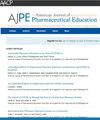评估医疗保健需求地区社区药房住院医师计划的地理分布。
IF 3.5
4区 教育学
Q1 EDUCATION, SCIENTIFIC DISCIPLINES
引用次数: 0
摘要
目的:评估美国卫生系统药剂师协会(ASHP)社区药房住院医师计划的地理分布与联邦指定的医疗保健需求和社会脆弱性的关系。方法:从2023年9月至2024年9月,通过三个阶段的方法收集社区药房住院医师项目地址:住院医师项目主任的初步质量调查、项目网站的审查和电话随访。使用ArcGIS Pro分析了268个地址(约占美国社区药房住院医师计划的80%),以评估其相对于三个联邦指标的分布:医疗服务不足地区(MUA)(得分≥62),初级保健卫生专业人员短缺地区(P-HPSA)(得分≥19)和疾病控制中心的社会脆弱性指数(cdc SVI)。结果:268个社区药房住院点中,37.3%为mua, 41.4%为P-HPSA。虽然68.3%的项目位于CDC SVI较高的地区,但只有2.6%的项目位于最脆弱的社区,这表明在最需要的地区存在有限。结论:在mua、p - hpsa和CDC svi中扩大社区药学住院医师计划可以提供解决医疗保健差距和改善获得药剂师主导的临床服务和医疗保健的重要策略。本文章由计算机程序翻译,如有差异,请以英文原文为准。
Assessing the Geographic Distribution of Community-Based Pharmacy Residency Programs in Areas of Health Care Need
Objective
To evaluate the geographic distribution of American Society of Health-System Pharmacists Community-Based Pharmacy Residency programs in relation to federally designated areas of health care need and social vulnerability across the United States.
Methods
Community-Based Pharmacy Residency Program addresses were collected from September 2023 to September 2024 through a 3-phase approach: an initial Qualtrics survey of Residency Program Directors, review of program websites, and telephone call follow-up. The resulting 268 addresses (approximately 80% of US Community-Based Pharmacy Residency programs) were analyzed using ArcGIS Pro to assess their distribution relative to 3 federal metrics: Medically Underserved Areas (MUA) (score ≥ 62), Primary Care Health Professional Shortage Areas (P-HPSAs) (score ≥ 19), and the Centers for Disease Control and Prevention (CDC) Social Vulnerability Index (SVI).
Results
Of the 268 Community-Based Pharmacy Residency sites, 37.3% were in MUAs and 41.4% in P-HPSAs. Although 68.3% of programs were in areas of higher CDC SVI, only 2.6% were in the highest-vulnerability communities, indicating limited presence in areas of greatest need.
Conclusion
The expansion of Community-Based Pharmacy Residency programs in MUAs, P-HPSAs, and CDC SVIs could present a vital strategy to address health care disparities and improve access to pharmacist-led clinical services and health care.
求助全文
通过发布文献求助,成功后即可免费获取论文全文。
去求助
来源期刊
CiteScore
4.30
自引率
15.20%
发文量
114
期刊介绍:
The Journal accepts unsolicited manuscripts that have not been published and are not under consideration for publication elsewhere. The Journal only considers material related to pharmaceutical education for publication. Authors must prepare manuscripts to conform to the Journal style (Author Instructions). All manuscripts are subject to peer review and approval by the editor prior to acceptance for publication. Reviewers are assigned by the editor with the advice of the editorial board as needed. Manuscripts are submitted and processed online (Submit a Manuscript) using Editorial Manager, an online manuscript tracking system that facilitates communication between the editorial office, editor, associate editors, reviewers, and authors.
After a manuscript is accepted, it is scheduled for publication in an upcoming issue of the Journal. All manuscripts are formatted and copyedited, and returned to the author for review and approval of the changes. Approximately 2 weeks prior to publication, the author receives an electronic proof of the article for final review and approval. Authors are not assessed page charges for publication.

 求助内容:
求助内容: 应助结果提醒方式:
应助结果提醒方式:


